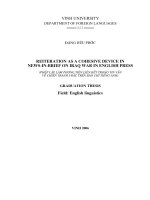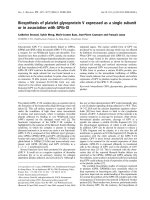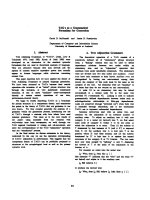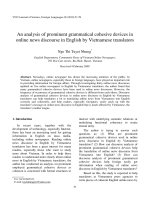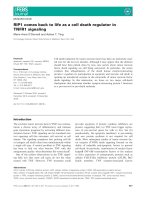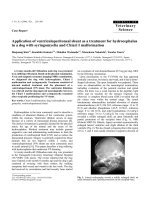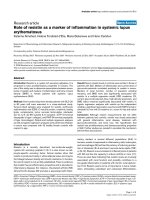substitution as a grammatical cohesive device in english narrative in comparision with its translation into vietnamese = phép thế như phương tiện liên kết ngữ pháp trong văn trần thuật tiếng anh
Bạn đang xem bản rút gọn của tài liệu. Xem và tải ngay bản đầy đủ của tài liệu tại đây (991.17 KB, 41 trang )
A
VIETNAM NATIONAL UNIVERSITY, HANOI
UNIVERSITY OF LANGUAGES AND INTERNATIONAL STUDIES
FACULTY OF POST- GRADUATE STUDIES
NÔNG VĂN HẢI
SUBSTITUTION AS A GRAMMATICAL COHESIVE
DEVICE IN ENGLISH NARRATIVE IN COMPARISON
WITH ITS TRANSLATION INTO VIETNAMESE
(Phép thế nhƣ phƣơng tiện liên kết ngữ pháp trong văntrần
thuật tiếng Anh so sánh với bản dịch sang tiếng Việt)
M.A. Minor programme thesis
Field: English Linguistics
Code: 60.22.15
HANOI, 2011
B
VIETNAM NATIONAL UNIVERSITY, HANOI
UNIVERSITY OF LANGUAGES AND INTERNATIONAL STUDIES
FACULTY OF POST- GRADUATE STUDIES
NÔNG VĂN HẢI
SUBSTITUTION AS A GRAMMATICAL COHESIVE
DEVICE IN ENGLISH NARRATIVE IN COMPARISON
WITH ITS TRANSLATION INTO VIETNAMESE
(Phép thế nhƣ phƣơng tiện liên kết ngữ pháp trong văn
trần thuật tiếng Anh so sánh với bản dịch sang tiếng Việt)
M.A. Minor programme thesis
Field: English Linguistics
Code: 60.22.15
Supervisor: Dr. DƢƠNG THỊ NỤ
HANOI, 2011
iv
TABLE OF CONTENTS
CONTENTS PAGES
DECLARATION I
ACKNOWLEDGEMENT II
ABSTRACT III
TABLE OF CONTENTS IV
LIST OF TABLES AND FIGURES VI
PART A: INTRODUCTION 1
1. RATIONALE 1
2. AIMS OF THE STUDY 2
3. SCOPE OF THE STUDY 2
4. METHODS OF THE STUDY 3
5. DESIGN OF THE STUDY 4
PART B: DEVELOPMENT 5
CHAPTER 1: THEORETICAL BACKGROUND 5
1.1 Discourse 5
1.1.1 The Concept of Discourse……………………… …………………… 5
1.1.2 Spoken and written discourse ……………… ……………………… 6
1.1.3 Narrative Discourse ………………………………………………… 8
1.1.4 Discourse Analysis ………………………….……………………… 9
1.2 Cohesion 10
1.2.1 The concept of cohesion ……………….…………………………… 10
1.2.2 Cohesion vs. Coherence …………………………………………… 11
v
1.2.3 Types of Cohesion …………… ………………………………… 12
1.2.3.1 Grammatical Cohesion
………………………… ……………………. 14
1.2.3.2 Lexical Cohesion …………………………… …………………. 20
1.3 Overview of translation 21
1.3.1 The Concept of Translation ……… ………………………………. 21
1.3.2 Important factors of Translation ……………… ………………… 21
1.3.3 The basis of translation ……………………………………… ……. 22
1.3.4 Source Language and Target Language ……………… …………… 22
2.1 English Substitution Devices 23
2.2 Vietnamese Solutions to the English Substitution Devices 26
2.2.1 Cohesive Devices ……………………………………………… …. 28
2.2.1.1 Grammatical Cohesion Devices
……………………………………… 28
2.2.1.2 Lexical Cohesion Devices ………………………………………. 31
2.3 Translation Techniques 32
PART C: CONCLUSION 33
REFERENCE: 35
vi
LIST OF TABLES AND FIGURES
Table 1. Type of cohesion
Table 2. Grammatical and Lexical cohesion
Table 3 Occurrences and frequency of cohesive items of substitution in Corpus A
Table 4. Occurrence and frequency of Vietnamese solutions to the English
substitution device
Figure 1: Reference
1
PART A: INTRODUCTION
1. RATIONALE
Discourse Analysis, or discourse studies, is a general term for a number of
approaches to analyzing written and spoken language use or any significant
semiotic event. From the beginning of its appearance, Discourse Analysis has taken
up in a variety of social science disciplines. It is now a rapidly expanding field,
providing insights into various aspects of language in use and therefore of great
importance to language teaching. In the early days, language teaching has been
concerned with pronunciation, grammar and vocabulary; however, it was not until
Discourse Analysis turned up that our awareness of how to put this knowledge into
action to gain successful communication was raised.
Literature, which plays a very important role in our spiritual life, has been
greatly developing as a consequence of the high living standards. As a matter of
fact, there have been more and more people choosing to work in the literary field
and their efforts have created so many famous works. It is open to questions as to
which factors have to be taken into consideration to make a successful work. How
important are those factors to the completion of a coherent and cohesive text?
Added to this, the knowledge of cohesion and coherence are actually regarded as
the crucial aspects of language usage.
Cohesion is considered one of the most challenging aspects of translation, as
any language has its own unique manners in which it employs cohesive devices in
the creation of a cohesive text. Each language has its own patterns to convey the
interrelationships between persons and events; these patterns may not be ignored in
a language if the readers understand what the translator wants to convey. The topic
of cohesion has always appeared as the most useful constituent of discourse analysis
that is applied to translation. English and Vietnamese have different grammars and
vocabulary structures, and it is only natural that they pose great difficulties and
challenges for a translator to deal with, especially in the field of literature.
2
Those reasons mentioned above are the most important ones that have
encouraged the author to conduct the study entitled “Substitution as a Grammatical
Cohesive Device in English Narrative in Comparison with Its Translation into
Vietnamese”. I hope that this study may help teachers and learners of foreign
language have an overall viewpoint on grammatical cohesive devices.
2. AIMS OF THE STUDY
Based on the detailed classification of cohesive devices in English of
Halliday and Hasan (1976), this study provides a close analysis of a particular
grammatically cohesive device employed in English and its equivalence in the
Vietnamese translation. This paper aims to study from a quantitative and a
qualitative point of view the possible shifts of cohesion in translation in literary
texts and solutions adapted to the Vietnamese translation.
Furthermore, this study compares the translation strategies that translators
use in transferring substitution from an English literary text to its Vietnamese
translation. This may pose great difficulties and problems because of the difference
between the two languages.
In order to achieve the aim of the study, some following research questions
are raised.
1. What are the possible shifts of cohesion within the text of translation in the
field of literature?
2. What are the main problems that may occur in translation through the use
of substitution?
3. What are the possible solutions adopted in the Vietnamese translation of a
literary text?
3. SCOPE OF THE STUDY
As Discourse Analysis has a very broad scope which has a very close
relationship with many other aspects of language study, it is impossible for the
author to refer to all of its characteristics. Thus, within this study, the author just
3
mentions some background knowledge about Discourse Analysis as well as
coherence and cohesion.
Halliday and Hasan (1976) make a detailed classification of the cohesive
devices in English. These authors distinguish between grammatical and lexical
cohesion. According to them, grammatical cohesion embraces four different
devices: Reference, substitution, ellipsis and conjunction. This study will only
focus on analyzing how substitution is used as a device of grammatical cohesion in
English narrative and its translated version into Vietnamese.
4. METHODS OF THE STUDY
To carry out this study, two literary corpora were used. They were identified
as Corpus A and Corpus B. The former was composed of the original texts written
in English entitled “pride and prejudice” and it was made up of 121.728 words.
The latter consisted of 141.370 words which was the Vietnamese translated version
of those very same texts. The literary text was chosen for analysis because it is a
famous literary work of Jane Austen. Added to this, I have read both the original
and the Vietnamese translated version for several times and find this story very
interesting to make an analysis. Both corpora have a digital format and are
available on the internet. Detailed information about the translations was not
available.
In the study, both quantitative and qualitative methods were adopted for
analysis. And the analysis was conducted in the following steps
- Firstly, make an identification in corpus A of the substitution devices
employed in English based one the classification theory of Halliday and Hasan. The
identification of such items was carried out with the help of a concordance
programme named Antconc 3.2.3w.
- Then, locate the equivalent linguistic expressions in Corpus B.
- Finally, discuss and analyze the solutions adopted in the Vietnamese
translation.
4
5. DESIGN OF THE STUDY
This study is divided into three main parts.
Part A is the introduction which includes rationale, aim, scope, method and design
of the study.
Then Part B is the development which consists of 2 chapters in which chapter one is
about the theoretical background of the study and chapter two is the analysis of
substitution as the device of grammatical cohesion in English narrative in
comparison with its Vietnamese translated version.
Part C is the conclusion which describes a summary of the present study with some
interesting findings.
5
PART B: DEVELOPMENT
CHAPTER 1: THEORETICAL BACKGROUND
1.1 Discourse
1.1.1 The Concept of Discourse.
There are different ways of understanding and defining discourse. Halliday
(1985) defines “Discourse is a multidimensional process”. According to Crystal
(1992) discourse is seen as “a continuous stretch of language larger than a
sentence, often constituting a coherent unit such as a sermon, argument, joke, or
narrative”. Cook (1989) has a similar perspective of discourse; he considers
discourse as “stretches of language perceived to be meaningful, unified, and
purposive”. In other words, as Brown and Yule state, discourse is language
material, either spoken or written, in actual uses by speakers (and writers) of the
language.
Since its introduction to modern science the term “discourse” has taken
various, sometimes very broad, meanings. In order to specify which of the
numerous senses is analyzed in the following dissertation it has to be defined.
Originally the word “discourse” comes from Latin “discursu”' which denoted
“conversation, speech”. Thus understood, however, discourse refers to too wide an
area of human life, therefore only discourse from the vantage point of linguistics,
and especially applied linguistics, is explained here.
There is no agreement among linguists as to the use of the term discourse in
that some use it in reference to texts, while others claim it denotes speech which is
for instance illustrated by the following definition: "Discourse: a continuous stretch
of (especially spoken) language larger than a sentence, often constituting a coherent
unit such as a sermon, argument, joke, or narrative" (Crystal 1992:25). On the other
6
hand, being aware of the differences between kinds of discourses indicates the unity
of communicative intentions as a vital element of each of them. Consequently she
suggests using terms 'text' and 'discourse' almost interchangeably betokening the
former refers to the linguistic product, while the latter implies the entire dynamics
of the processes. According to Cook (1994:7) novels, as well as short conversations
or groans might be equally rightfully named discourses.
Seven criteria which have to be fulfilled to qualify either a written or a
spoken text as a discourse have been suggested by Beaugrande (1980). These
include:
Cohesion - grammatical relationship between parts of a sentence essential
for its interpretation;
Coherence - the order of statements relates one another by sense.
Intentionality - the message has to be conveyed deliberately and
consciously;
Acceptability - indicates that the communicative product needs to be
satisfactory in that the audience approves it;
Informativeness - some new information has to be included in the discourse;
Situationality - circumstances in which the remark is made are important;
Intertextuality - reference to the world outside the text or the interpreters'
schemata;
Nowadays, however, not all of the above mentioned criteria are perceived as
equally important in discourse studies, therefore some of them are valid only in
certain methods of the research (Beaugrande 1980: 49).
1.1.2 Spoken and written discourse
Talking and writing represent different modes of expressing linguistics
meanings. As stated by Halliday (1985) “Speaking does not show clearly sentence
7
and paragraph boundaries or signal the move into direct quotation while writing
leaves out the prosodic and paralinguistic contribution”. While written discourse
comprises complete sentences with subordination, rich lexis and frequent
modifications via adjectives and adverbs, spoken contains incomplete sentences.
Although spoken and written discourses share the communicative functions, they
serve various functions. The former is concerned with interact ional use and the
latter with the transactional use (Brown and Yule, 1983: 13)
By comparison, writing language is under no temporal, spatial pressure. The
writer has time to choose lexical items, check words and structures to make
necessary correction which is primarily concerned with the transactional use.
Spoken language, as stated by Brown and Yule (1983), is the kind of language
which is produced under some temporal, spatial pressure with the speaker’s
monitoring of what it is that he has just said, determining his current phrase and
simultaneously planning his next utterance and which is primarily concerned with
the interactional use.
There are three prominent features that can apply to distinguish written and spoken
discourse.
1. Density: the density is the information volume presented. Evidently, written
language is dense while spoken language is sparse.
2. Complexity of grammar: in spoken language grammar is not so important,
but information. For written language, it is important to maintain enough
information, appropriate grammatical structures as well as rational
organization of sentences.
3. Grammatical metaphor: Written language presents rather few different verbs,
whereas spoken language uses more verbs.
These above characteristics are inherent in spoken and written language in
whatever types of discourse. Written texts can be read out and heard such as letters,
stories, novels, contracts, reports, speeches. Moreover, spoken discourse such as
8
lectures, lessons, interviews, conversations and so on can also be reserved in the
form of writing.
1.1.3 Narrative Discourse
Narrative discourse is a skill generally designed to entertain. It is typically
oriented around characters and events and conforms to a superstructure that consists
of the following elements: setting, complicating action, and resolution. Narrative
discourse provides speakers the opportunity to express temporal progression,
establish and maintain personal reference, and highlight certain events above others.
This facilitates a more natural flow of information that represents normal
communication. The assessment of narrative discourse has received notable
attention in the speech-language literature. The study of discourse in individuals
with compromised brain function offers a method for testing the interaction of the
multiple cognitive processes such as attention, memory, and organization that
involved in the production of discourse.
Narrative discourse typically contains characteristics of cohesion. Cohesion
is a semantic concept; it refers to relations of meaning that exist within a passage,
spoken or written, and define it as a passage. Glosser (1993: 191) notes that
discourse cohesion occurs via linguistic devices that index interconnections of
multiple segments of the discourse. More specifically, cohesion occurs in narrative
discourse via the use of cohesive markers, which are words that direct the listener to
information found outside individual sentences. Therefore, cohesion is a semantic
relationship between an element in the passage and some other element that is
crucial to its translation. The cohesive marker creates a tie with the information
found outside the sentence and establishes a meaning relationship across sentences
within the passage.
Halliday and Hasan (1976) proposed a methodology for cohesion analysis
and noted that the basic concept employed in analyzing cohesion of a passage is that
of the cohesive tie. The tie includes the cohesive element in addition to that which is
presupposed by the cohesive element. Five categories of cohesive elements or
9
markers were defined by Halliday and Hasan: reference, substitution, ellipsis,
conjunction, and lexical markers or general nouns. Reference consists of personal,
demonstrative, and comparative pronouns (e.g., the motorbike belongs to her).
Substitution is a relation in the wording rather than meaning. Substitutions are
alternate words used in the place of a repetition of a particular item (e.g., Our
television is broken. We need to buy a new one). Ellipsis is the omission of an item
(e.g., Did you hear the news? No, only the weather). Conjunctions are cohesive
indirectly as they express certain meanings that presuppose the presence of other
discourse components.
1.1.4 Discourse Analysis
Discourse analysis is a primarily linguistic study examining the use of
language by its native population whose major concern is investigating language
functions along with its forms, produced both orally and in writing. Moreover,
identification of linguistic qualities of various genres, vital for their recognition and
interpretation, together with cultural and social aspects which support its
comprehension, is the domain of discourse analysis. To put it in another way, the
branch of applied linguistics dealing with the examination of discourse attempts to
find patterns in communicative products as well as and their correlation with the
circumstances in which they occur, which are not explainable at the grammatical
level (Carter 1993:23).
Discourse analysis is a branch of linguistics that studies language use in
relation to social factors that influence our daily interactions. It deals with the way
people use language in its appropriate context. E.e, in certain ways to have certain
affects; In order to construct versions of their expressions according to Yule
(1996:83): “when it is restricted to linguistic issue, discourse analysis focuses on the
record (spoken and written) of the process by which language is used in some
contexts to express intention.” The focus of discourse is any form of written or a
spoken language such as conversation, dialog, articles, books and so on. Discourse
analysis is often described as “language in use” by means; the way of understanding
10
social interaction, and how written and spoken texts are used in a specific contexts
to make meanings. “It tends to focus specifically on aspects of what is unsaid or
unwritten (yet communicated) within the discourse being analyzed” (Yule,
1987:84). So discourse analysis is all what people perceive or think about any given
topic.
1.2 Cohesion
1.2.1 The concept of cohesion
The concept of cohesion is closely connected with text. It is defined as the
grammatical and lexical relationship between different elements of a text.
According to Yule (1996), a text is usually considered to have a certain structure
which depends on factors quite different from those required in the structure of
single sentence. Some among those factors are described in terms of cohesion, or
the ties and connection which exist within a text.
Halliday and Hasan (1976:4) also define cohesion in a similar way: "The
concept of cohesion is a semantic one; it refers to relations of meaning that exist
within a text, and that defines it as a text". They also point out that cohesion often
occurs where the interpretation of some elements in the discourse is dependent on
that of another.
Baker (1992) relates cohesion to the study of textual equivalence defining it
as “the network of lexical, grammatical, and other relations which provide links
between various parts of a text”. The important role of cohesion is to build up
sentences in any given text. This comes through the linking of different parts of a
text to each other so that it gives a structure to a text. It helps in hanging sentences
together in a logical way, for having a right meaning. So, cohesion has a relation
with the broader concept of coherence.
1.2.2 Cohesion vs. Coherence
The distinction between cohesion and coherence has not always been
clarified partly because both terms come from the same verb cohere which means
11
sticking together. In fact, cohesion is the network of different kinds of formal
relations that provide links between or among various parts of a text, and is
expressed partly through the grammar and partly through the vocabulary.
Coherence, in contrast, can be understood as the quality of being meaningful and
unified. As for Nunan (1993), coherence is "the feeling that sequences of sentences
or utterances seem to hang together".
The concept of cohesion refers to relations of meaning that exist within the
text, and that defines it as a text. Cohesion occurs where the interpretation of some
element in the discourse dependent on that of another.
Cohesion is the network of lexical, grammatical, and other relations which
link various parts of a text. These relations or ties organize and, to some extent,
create a text, for instance, by requiring the reader to interpret words and expressions
by reference to other words and expressions in the surrounding sentences and
paragraphs. Cohesion is a surface relation and it connects together the actual words
and expressions that we can see or hear.
Halliday and Hasan (1976) identify five main cohesive devices in English:
reference, substitution, ellipsis, conjunction, and lexical cohesion.
E.g. American Life Inc. pays the mortgage on each property from its own
funds until the mortgage is paid in full. The Company‟s principals have made
personal guarantees covering all debt and no debt is cross-collateralized
among the properties and partnerships.
Reading this example, we can understand that there is a link between
„American Life Inc.‟ and „the Company‟’.
Coherence, on the other hand, is defined as the relationships of various ideas
in a text that are linked together to create a meaningful discourse. According to
Nunan (1993) coherence is “the feeling that sequences of sentences or utterances
seems to hang together and make sense. In short, coherence means the relationships
12
that link the meanings of utterances in a discourse or of the sentences in a text.
These links may be based on the speakers’ shared knowledge.
E.g. The aviation business includes handling aircrafts and passengers,
offering security check, services of security guard, fire fighting and other
ground services.
In the above example, there is a conceptual relationship among the aviation
business and other terms in the text.
Though cohesion and coherence, in essence, is different from each other,
they are closely linked together. They represent the very essential elements that
make a text or discourse coherent and that make coherent text or discourse different
from random sentences or utterances. Cohesion is mainly used to embody
coherence by a system of cohesive devices. Accordingly, cohesion and coherence
help consolidate the text as a complete and unified linguistics unit beyond the
largest syntactic unit of sentence.
1.2.3 Types of Cohesion
According to Halliday and Hasan (1976), the classification of cohesion is
based on the linguistic form. The type of cohesion depends either on semantic
relation in the linguistic system or on lexico-grammatical relations. In other words,
the cohesive relation can be interpreted as being either lexico-grammatical in nature
or semantic. It can be made clearer in the following description:
Nature of cohesive relation
Type of cohesion
Relatedness of form
Relatedness of reference
Semantic connection
Substitution and ellipsis; lexical
collocation
Reference; lexical reiteration, Conjunction
Table 1. Type of cohesion
(Source: Halliday and Hasan, 1976:304)
Reference, substitution and ellipsis are clearly grammatical; lexical cohesion,
as the name implies, lexical. Conjunction is on the borderline of grammatical and
13
the lexical; the set of conjunctive expressions involve lexical selection. However, it
is better to put it in the group of grammatical cohesion as it is mainly grammatical
with a lexical component inside. Consequently, we can refer to grammatical
cohesion and lexical cohesion as follows:
Grammatical cohesion
Lexical cohesion
Reference
Exophoric
Endophoric
- personal
- demonstrative
- comparative
Substitution
Nominal
substitution
Verbal substitution
Clausal
substitution
Ellipsis
Nominal ellipsis
Verbal ellipsis
Clausal ellipsis
Conjunction
Additive
Adversative
Causal
Temporal
Others
Reiteration
Same word/repetition
Synonym/near
synonyms
Superordinates
General words
Collocation
Noun + Noun
Adjective + Noun
Verb + Noun
Noun + Preposition
Adjective +
Preposition
Adverb + Adjective
Verb + Preposition
Table 2.
Grammatical and Lexical cohesion
1.2.3.1 Grammatical Cohesion
As mentioned above, grammatical cohesion consists of four subtypes, they are
Reference, Substitution, Ellipsis and Conjunction. Below, by analysing some typical
14
examples, the author attempts to go into detail with each type with a view to giving
an overall background of grammatical cohesion.
Reference
To begin with, in the view of Halliday and Hasan (1976:32), reference is a
semantic relation and "since the relationship is on the semantic level, the reference
item is in no way constrained to match the grammatical class of the item it refers
to".
The two authors also distinguish situational and textual reference very
clearly by contrasting exophora (or exophoric reference) and endophora (i.e,
endophoric reference) as follows:
Reference
[situational] [textual]
exophora endophora
[to preceding text] [to following text]
anaphora cataphora
Figure 1: Reference
(Source: Halliday and Hasan, 1976:33)
They then conclude that reference items may be exophoric or endophoric;
and if endophoric, they may be anaphoric or cataphoric. These two authors also
indicate: "There are items in every language which have the property of reference".
In English, those items belong to anaphoric and cataphoric reference. The first
15
consists of items which point the readers or listeners backwards to a previously
mentioned entity, process or state of affairs. The second, on the other hand, points
the readers or listeners forward further into the text in order to identify elements to
which the reference items refer.
To take an example, let us look at the opening lines of a famous English
novel, Jude the Obscure. The author, Thomas Hardy, shows different types of
reference at work:
The schoolmaster was leaving the village, and everybody seemed sorry. The
miller at Cresscombe lent him the small white tilted cart and horse to carry
his goods to the city of his destination, about twenty miles off, such a vehicle
providing of quite sufficient size for the departing teacher's effects.
In this example, there are both anaphoric and exophoric reference. The followings
are detailed analysis of such types of reference.
+ Anaphoric Reference:
In the first sense, him in "lent him the small white tilted cart" is the
schoolmaster introduced earlier, his destination is the schoolmaster's and such a
links back to the cart in the previous sentence; therefore, all the expressions “him,
his destination, such a” are referred to as anaphoric reference.
+ Exophoric Reference:
The novel opens with "the schoolmaster" leaving "the village". We have no
information about which schoolmaster and which village that the writer is referring
to. In this case, the author expects us to share a world with him, independent of the
text, with typical villages and their populations (everybody), their schoolmaster and
miller. These ones are exophoric reference.
Now consider the following example of reference with the pronoun "she":
Although she was still tired, my sister managed to go to school.
In this particular text, neither anaphoric nor exophoric reference supplies the
identity of "she", we have to read on, and are given the identity in the following part
of the sentence. “She” here is cataphoric reference.
16
Also according to Halliday and Hasan, there are three types of reference:
personal, demonstrative, and comparative. The first is reference by means of
function in the speech situation, through the category of PERSON, such as: I, me,
you, we, us (noun/pronoun); mine, my, your, yours, one's (determiner); etc. The
second is reference by means of location, on a scale of PROXIMITY, such as: this,
these, here, now (near proximity); that, those, there, then (far proximity); or the
(neutral proximity). The last is indirect reference by means of IDENTITY or
SIMILARITY, such as same, identical, equal, identically (identity-general
comparison); similar, additional (general similarity - general comparison); other,
different, else, differently, otherwise (difference); better, more, so, equally
(particular comparison).
These various devices enable the writer or speaker to make multiple
references to people and things within a text. Examples of these types are as
follows:
1. Peter didn't come to the party. He is too busy typing his reports for the
next meeting.
In this example, both “Peter” and “he” refers to the same person. “He” in the second
sentence is regarded as personal reference.
2. Tom is always the last person to enter the meeting hall. This annoys his
colleagues.
As can be seen, “This” replaces the meaning of the whole preceding sentence. In
this case, “this” is demonstrative reference.
3. I'm not so happy as he.
In the last example, “so” is used as comparative reference.
Substitution
The second type of grammatical cohesion analyzed below is substitution.
Substitution is a relation in the wording rather than in the meaning and within the
text. It is the use of substitute word or phrase to avoid repetition. Most of the
17
substitutes are proforms within sentences, which can be used across sentences.
There are three types of substitution: nominal substitution, verbal substitution and
clausal substitution. Substitutes may be proforms for nouns (one/ ones); proforms
for adverbials (there, like it, like that, ); proforms for predicates and predication
(do so, do it, do that, so do/does); proforms for the direct object clause (that, so,
). According to Halliday and Hasan (1976), nominal substitution includes: one,
ones, same; verbal substitution consists of do; and clausal substitution are so, not.
The following are some examples of substitution.
+ Nominal substitution
There are some new tennis balls in the bag. These ones have lost their
bounce.
In the second sentence, “ones” refers to the noun phrase “tennis balls” appearing
before. It is, therefore, called nominal substitution.
+ Verbal substitution
A: Did Mary take that letter?
B: She might have done.
The verb “done” in B’s answer is a substitute of the verb phrase “take that letter”.
In this case, “done” is an example of verbal substitution.
+ Clausal substitution
A: Is it going to rain?
B: I think so.
We can see clearly from this conversation that B agrees with A’s idea and the word
“so” substitutes the clause “it is going to rain”. “So” is clausal substitution.
Ellipsis
Ellipsis is an omission of certain elements from a sentence or clause and can
only be recovered by referring to an element in the proceeding text. The former is
non-cohesive, and the latter is cohesive. Elliptical cohesion always appears
18
anaphoric. Ellipsis can be repetition. This is similar to substitution in terms of three
types: nominal ellipsis, verbal ellipsis and clausal ellipsis.
+ Nominal ellipsis:
My kids play an awful lot of sport. Both [ ] are incredibly energetic.
In this instance, in order to be fully interpreted, the sentences must be filled with
“my kids” in the gap. However, these are omitted as it is not necessary for readers
to work out the sentence’s meaning.
+ Verbal ellipsis:
A: Have you been working?
B: Yes, I have [ ]
Similarly, there is no need to repeat the verb in this sentence as it presupposes the
word from the previous verbal group. The full answer for A’s question is “Yes, I
have been working”. Hence, B’s response here is known as verbal ellipsis.
+ Clausal ellipsis:
A: Why'd you only set three places? Paul's staying for dinner, isn't he?
B: Is he? He didn't tell me [ ].
B’s answer in this case can be understood as “He didn‟t tell me he is staying for
dinner”. As this clause is omitted, this sentence is considered as an example of
clausal ellipsis.
Conjunction
Conjunction, as described by Bloor and Bloor (1995: 98) acts as a
“cohesive tie between clauses or sections of text in such a way as to demonstrate a
meaningful pattern between them”, though Halliday and Hasan (1976: 227)
indicate that “conjunctive relations are not tied to any particular sequence in the
expression”. Therefore, amongst the cohesion-forming devices within text,
conjunction is the least directly identifiable relation. Conjunction acts as a
semantic cohesive tie within text in four categories: additive, adversative, causal
and temporal. Additive conjunction acts to structurally coordinate or link by
adding to the presupposed item and are signaled through “and, also, too,
19
furthermore, additionally”, etc. Additive conjunction may also act to negate the
presupposed item and is signaled by “nor, and Not, either, neither”, etc.
Adversative conjunctions act to indicate “contrary to expectation” (ibid: 250) and
are signaled by “yet, though, only, but, in fact, rather”, etc. Causal conjunction
expresses “result, reason and purpose” and is signaled by “so, then, for, because, for
this reason, as a result, in this respect, etc” and adverbs: consequently, accordingly.
The last conjunctive category is temporal and links by signaling sequence or time.
Some sample temporal conjunctive signals are “then, next, after that, next day, until
then, at the same time, at this point”, etc.
Conjunction is different from substitution, ellipsis and reference in the fact
that it is not a device for reminding the readers of previously mentioned entities,
actions and state of affairs. It is not in the kind of anaphoric relation. But it is a truly
cohesive device because it signals relationships that can only be fully understood
through reference to other parts of the text. There are four types of conjunction:
temporal, causal, additive and adversative. Following are some examples of
conjunctive relations:
- Temporal: then, next, after that, just then, at the same time, finally, at last, at once,
soon, after a time, next time, on another occasion, meanwhile, until then, etc.
We have been looking for that book for months. Finally, we manage to get
it.
- Causal: so, then, hence, therefore, consequently, for this reason, account for this,
as a result, with this in mind, for, because, on this basis, to this end, arising out of
this, in that case, that being so, under the circumstances, otherwise, in this respect,
with reference to this, aside from this, etc.
As a student, he was very lazy. Consequently, he failed his entrance
examination to university.
- Adversative: yet, though, however, only, nevertheless, despite this, in fact,
actually, on the other hand, at the same time, instead of, on the contrary, at least, in
any case, anyhow, at any rate, etc.
20
I have lived here for ten years; however, I've never heard of that pub.
- Additive: and, and so, nor, furthermore, in addition, besides, alternatively,
incidentally, by the way, that is, I mean, in other words, for instance, thus, likewise,
similarly, in the same way, by contrast, etc.
She is intelligent. And she is also very reliable.
1.2.3.2 Lexical Cohesion
Lexical cohesion was first advanced by Firth (1957) and later developed by
Halliday. Lexical cohesion occurs when two words in a discourse are semantically
related in some way. Halliday and Hasan (1976) classify lexical cohesion into two
main categories: reiteration and collocation.
Reiteration
Reiteration, according to Halliday and Hasan (1976), is "the repetition of a
lexical item, or the occurrence of a synonym of some kind, in the context of
reference; that is, where the two occurrences have the same referent". Reiteration
involves repetition, synonyms and near synonyms, superordinates, and general
words.
The meeting commenced at six thirty. But from the moment it began, it was clear
that all was not well.
Collocation
Collocation is known as the tendency to co-occur in the same lexical
environment without depending on any semantic relationships.
E.g.: A: Would you mind filling the kettle and switching it on? (1)
B: I need boiling water for vegetable. (2)
In (1) we have the word “kettle” and in terms of meaning, two words “fill”
and “switch” which may be used to combine with “kettle” appear in our minds.
Likewise, in (2) we have “water” and “boil” in our mind. These are known as
collocation.
